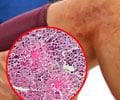The scientists found that mice lacking the Fox genes developed asthma-like symptoms, including the contraction of smooth muscle cells in the airway system.

‘A molecule called neuropeptide Y caused airway hyper-responsiveness in human lungs which is a classic sign of asthma.’





Asthma is a chronic condition that affects more than 25 million people in the United States alone, including more than 7 million children. It accounts for nearly 2 million ER visits annually and about 1.5 million patient-days of hospital inpatient care. "Only 60 percent of asthma patients have an inflammatory or allergic component to their asthma and 40 percent of asthma patients wheeze in part due to intrinsic abnormalities of epithelial and smooth muscle cells," said co-senior author Edward E. Morrisey, PhD, a professor of Cell and Developmental Biology and director of the Penn Center for Pulmonary Biology at Penn.
"Curiously, these patients are refractory to current therapies," said co-senior author Reynold A. Panettieri, Jr., MD, Vice Chancellor of Translational Medicine and Science at Rutgers. "There's a real need to understand the non-inflammatory aspects of asthma, and with this study we're getting closer to that understanding."
The study, which appears in the current issue of the Journal of Clinical Investigation, is a collaboration between the Morrisey laboratory and the laboratory of Panettieri, an asthma specialist who moved from Penn Medicine to Rutgers Biomedical and Health Sciences last summer.
Clues from Goblet Cells
Advertisement
Increased goblet cell differentiation in the airways is a hallmark of asthma. From this, the Morrisey lab investigated whether loss of the Foxp1/4 genes, specifically in the airway epithelium of the lung, also causes an asthma-like condition in mice.
Advertisement
A classic sign of asthma is airway hyper-responsiveness (AHR)-an abnormally strong tendency for the smooth muscle cells underlying the airway epithelium to contract and cause a partial closure of the airway. The team found that the mice lacking airway Foxp1/4 showed significantly greater signs of AHR, compared to control mice, especially when experimentally challenged with airway irritants.
"At the high doses of the challenge the Foxp1/4-knockout mice started to die because their airways closed off," Morrisey said. Intriguingly, the airway lining in the Foxp1/4-knockout mice did not show signs of the type of inflammation that is typically associated with asthma and targeted with standard asthma drugs.
Neuropeptide Y - The Key to Non-inflammatory Asthma?
To find out the principal cause of the hyper-responsiveness in the airways of these mice, the researchers looked at the gene expression patterns of the affected airway epithelial cells, comparing them to the patterns seen in control mice that have normal levels of Foxp1/4 expression.
"Because only Foxp1/4 genes were missing from the airway epithelium of these mutant mice, we hypothesized that epithelial cells in the mutants were secreting a factor that was causing the underlying smooth muscle cells to contract. Therefore, we looked specifically for expression changes in genes encoding molecules that could be secreted from the epithelial cells and be received by the airway smooth muscle cells," Morrisey said.
One such molecule, neuropeptide Y (NPY), stood out well above the rest-it was not expressed in control airway epithelial cells but was expressed at high levels in the airway epithelia of the knockout mice.
NPY is a signaling molecule and neurotransmitter found abundantly in the nervous system and some other parts of the body. Its many biological actions include stimulating the constriction of blood vessels. Previous research has linked variants of its gene to increased asthma risk, but NPY hasn't been known to have a direct role in asthma.
Morrisey's team showed that NPY has a significant role in asthma by deleting the NPY gene while at the same time deleting the Foxp1/4 genes. This resulted in the airway hyper-responsiveness that is observed in Foxp1/4-mutant mice to return to almost normal levels. Importantly, since changes in NPY expression have been linked to asthma in humans, the investigators tested whether NPY could directly cause airway hyper-responsiveness in human lung tissue. These experiments showed that when normal human lung airways are exposed to NPY, they exhibit a marked increase in hyper-responsiveness to methacholine challenge. In all of these experiments, the inflammatory response remained unchanged, indicating that NPY did not cause alterations in the immune response that could cause asthmatic symptoms.
"These data strongly suggest that NPY can cause airway hyper-responsiveness in human lungs and could be a causative mechanism in human asthma," Morrisey said.
"Further, the molecular mechanisms mediating airway hyper-responsiveness occur at the level of smooth muscle where NPY amplifies smooth muscle contraction at all mediators by activating Rho Kinase, a pivotal signaling molecule in the bronchoconstriction pathway," Panettieri said. It also suggests that inhibiting NPY activity in people with asthma, perhaps with an inhaled medication, might help the millions of patients who get little or no benefit from current asthma therapies.
Pharmaceutical companies have already developed compounds that block NPY signaling for other applications such as obesity and hypertension. "Testing whether these NPY inhibitors would help human asthma patients would be worthwhile given the results of our studies" Morrisey said.
In addition to setting up tests of NPY-blocking drugs, he and his team hope to replicate their mouse-model findings in a larger animal model of asthma, which better simulates the human disease.
Source-Newswise















